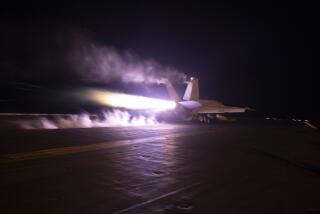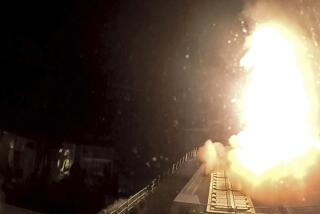U.S.-Australia war games bomb Great Barrier Reef, stirring uproar
Four unarmed bombs jettisoned by U.S. fighter jets in an emergency action last week have settled in relatively shallow water 18 miles from Bell Cay in the Great Barrier Reef Marine Park, reportedly posing no imminent threat to navigation or the 1,200-mile-long reef that is the world’s largest organic construction.
But the 2,000 pounds of inert explosive devices at the edge of the World Heritage Site have upset environmentalists and guardians of marine resources who see the accident during U.S.-Australian military exercises as the latest indignity to which the reef has been subjected.
Pressures on the ecologically diverse and sensitive reef are multiple and multiplying: Climate change. Agricultural runoff. Growing maritime traffic off the Queensland coast. Megaport construction to handle Australia’s booming coal-seam gas exports.
The U.S. Navy’s 7th Fleet insisted in a statement issued Saturday that the bombs, dropped by two AV-8B Harrier aircraft launched from the amphibious assault ship Bonhomme Richard, posed no environmental or safety threat.
The Great Barrier Reef Marine Park Authority also said the bombs were of “low risk to the marine environment.” But the authority, which is the Australian government’s manager of the 134,000-square-mile reef under U.N. protection, called it a priority for the military to remove the ordnance from the site.
“I’m waiting for the U.S. Navy to tell us what their plan is to shift them,” Russell Reichelt, chief executive of the authority, told News.com.au, an Australian news website. “They might represent a hazard, long term, and I think it’s prudent to deal with this straight away. I don’t want them sitting down there and rusting through.”
The Brisbane Times on Monday reported that the Navy was consulting with Australian authorities about a possible operation to retrieve the bombs from their resting place under 164 feet of water on the coastal seabed.
The bombs were jettisoned last Tuesday, the second day of the U.S.-Australian war games Talisman Saber. The mock bombing was supposed to have been conducted over the Townshend Island range off the coast of Queensland, but the pilots were waved off at the last minute because unauthorized boats were spotted in the area. The jets couldn’t return to land on the deck of the Bonhomme Richard with the bombs still attached, so the reef area was chosen for the scuttling operation when the planes were in danger of running out of fuel, the Navy statement said.
Despite the assurances that the incident posed little environmental threat, ecologists and leftist politicians deplored the accident and the holding of military exercises so close to the reef.
“Have we gone completely mad?” an incredulous Larissa Waters, an Australian senator from the Greens party, said in an interview with the Australian Broadcasting Corp. “Is this how we look after our World Heritage area now? Letting a foreign power drop bombs on it?”
The dumping of the war games mock ordnance into the reef park was “just the latest insult to a delicate ecosystem already under siege from a variety of man-made threats,” National Geographic reported in a compilation of the indignities to which the reef has been subjected of late.
The magazine quoted Felicity Wishart of the Australian Marine Conservation Society as blaming poor land management for 17 million tons of river-borne, pesticide-laden agricultural runoff into the waters off the northeastern coast. The nutrients have spawned outbreaks of crown-of-thorns starfish, a species that Wishart said can eat its weight in coral every day and has already damaged large parts of the reef.
Queensland is also a key site of hydraulic fracturing, or “fracking,” of coal-seam gas, as the Los Angeles Times reported last year. That is driving a push by maritime trade developers to create massive terminals for ships that can carry the liquefied natural gas output to energy-hungry Asian markets.
The widening array of pressures on the reef’s delicate ecosystems are converging to damage the coral organisms, a U.S.-government funded study warned last year.
ALSO:
Royal baby born: Read the palace’s official statement
Pope Francis arrives in Brazil in return to native continent
Norwegian who reported rape in Dubai ‘pardoned’ but laws still target victims
More to Read
Sign up for Essential California
The most important California stories and recommendations in your inbox every morning.
You may occasionally receive promotional content from the Los Angeles Times.











